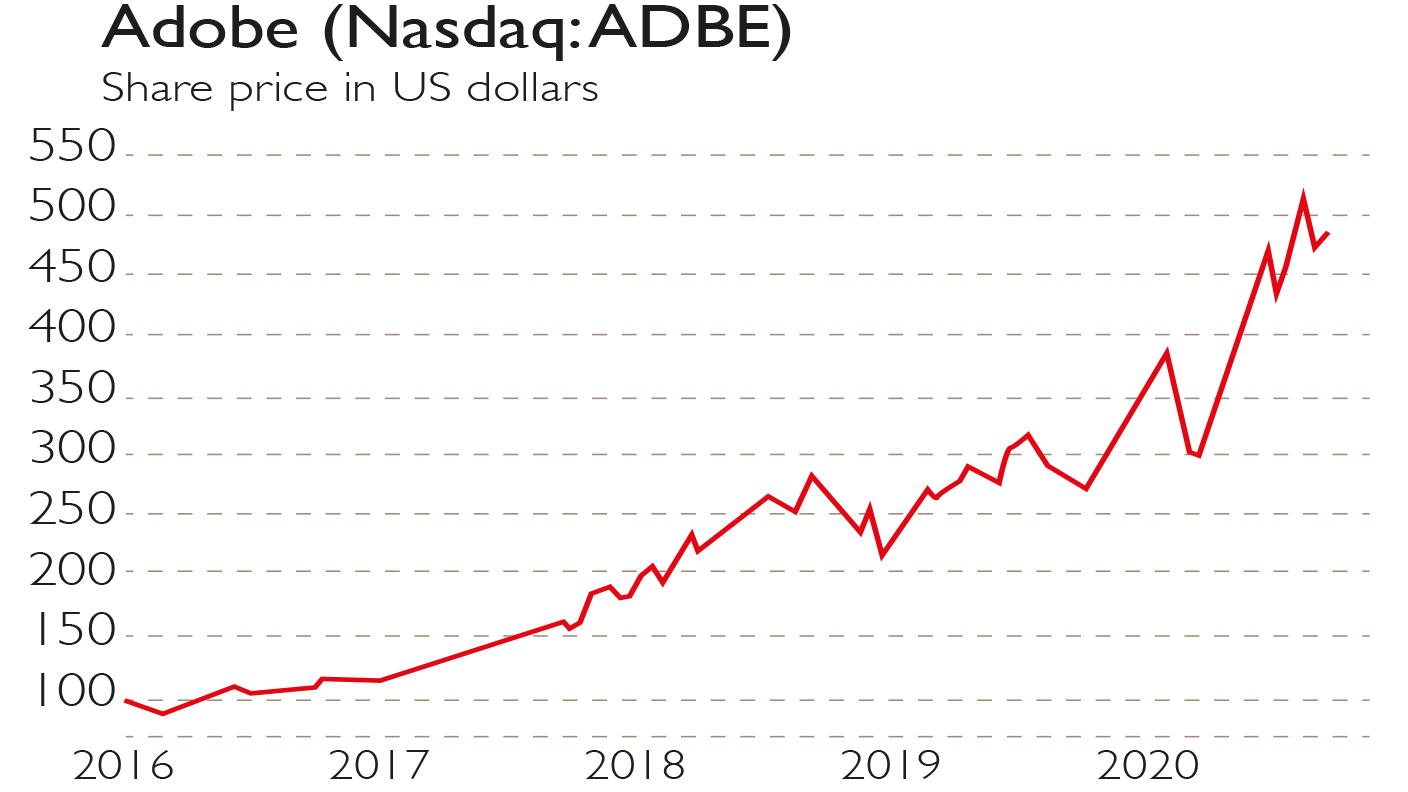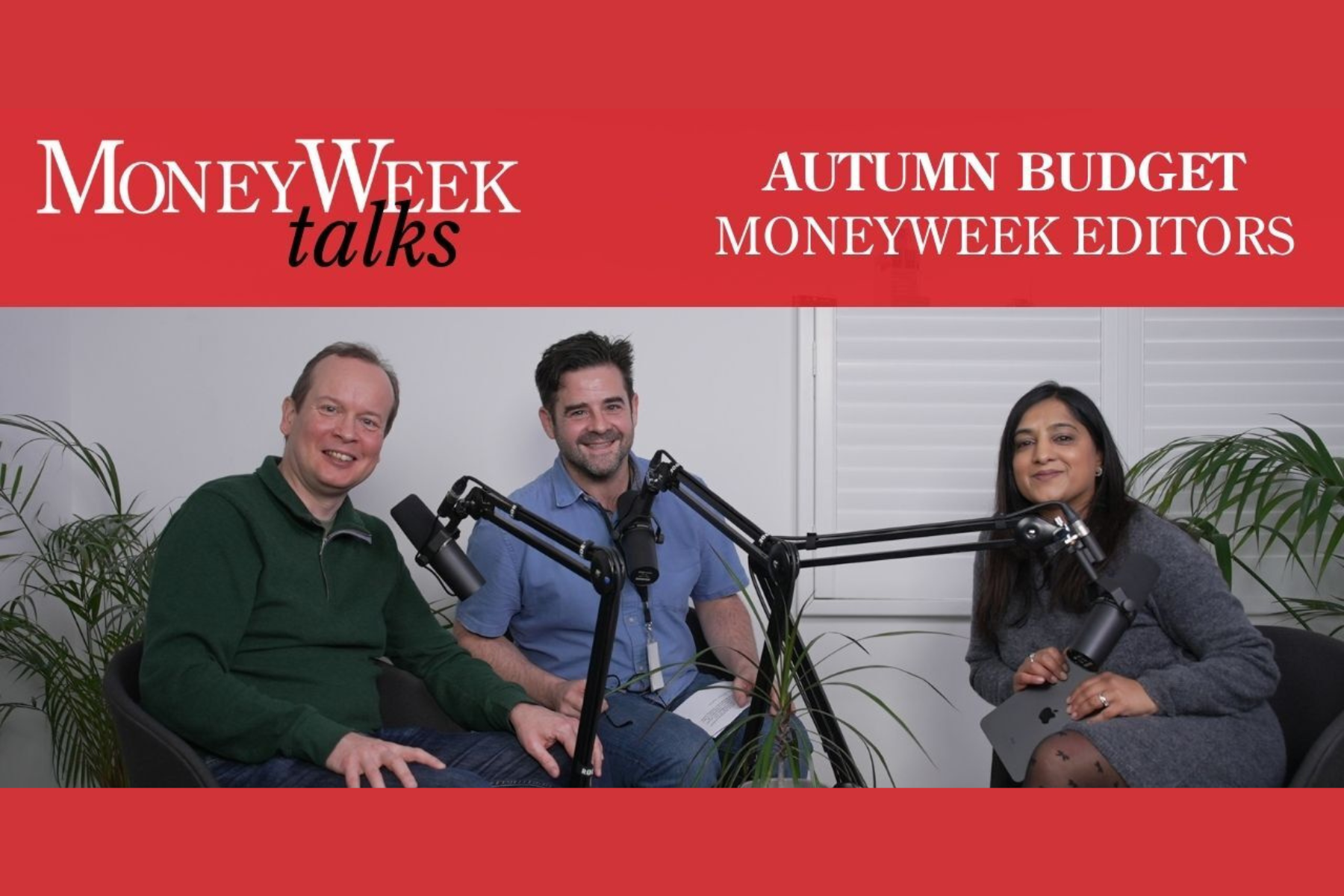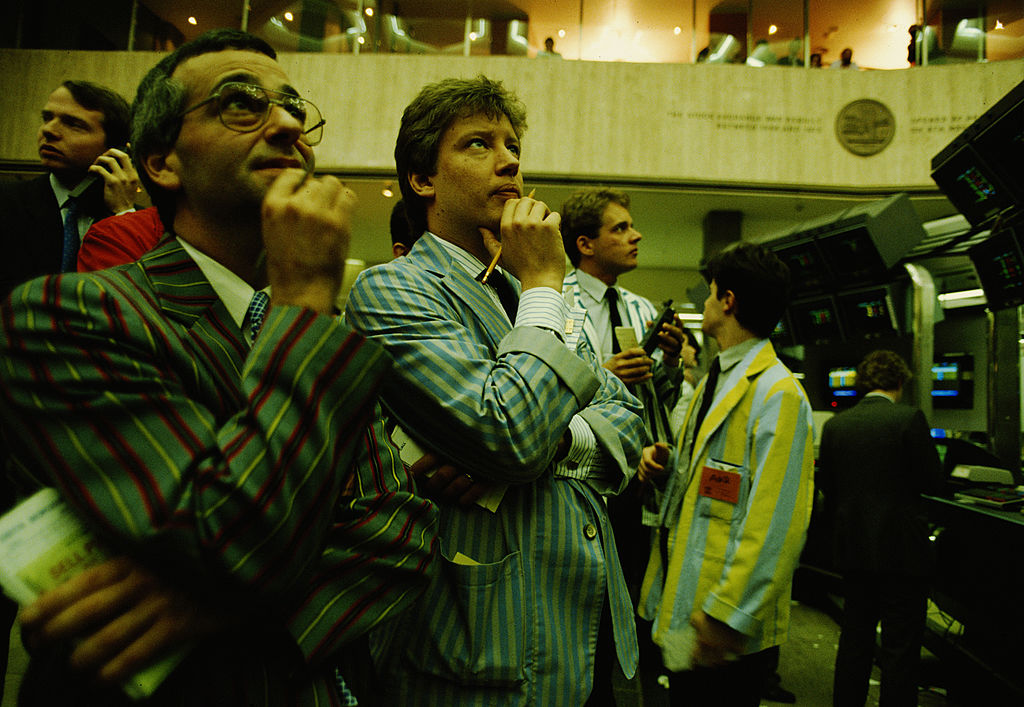Software giant Adobe will keep beating the rest
Adobe is in perfect position to profit from the remote-working revolution, says Stephen Connolly.

Creative-software group Adobe (Nasdaq: ADBE) came out with record-breaking results this week, beating analysts’ expectations yet again. Exceptional businesses are rare but Adobe is one of them. Over the past five years, profits have leapt 60% annually and cashflow is up over 300%, while gross margins have averaged an eye-catching 86%. And that was before the pandemic. Covid-19 has clearly triggered the need for even more digitisation, and at a faster pace as technology plays an increasing role in our lives. Adobe, which makes this happen, will be enjoying tailwinds for years to come.
An obscure giant
Despite being extremely profitable and a top-performing stock – the shares have grown 26.5% a year since floating in 1986 – Adobe isn’t that well-known. For many, it’s simply the maker of the Acrobat software that creates and reads PDF documents. For others, it’s the publisher of Photoshop, the program for editing pictures. Both are very important. Over 250 billion PDFs are opened a year in Adobe software, and 90% of the world’s creative professionals use Photoshop, which is to images what Microsoft Word is to text. But today Adobe is broader, offering a suite of software for document management and storage; website design, content and e-commerce; and image and video editing.
These have been highly successful as Adobe’s profit history shows. This growth should continue because they plug directly into the theme of the digitising world.
MoneyWeek
Subscribe to MoneyWeek today and get your first six magazine issues absolutely FREE

Sign up to Money Morning
Don't miss the latest investment and personal finances news, market analysis, plus money-saving tips with our free twice-daily newsletter
Don't miss the latest investment and personal finances news, market analysis, plus money-saving tips with our free twice-daily newsletter
First, we know many professionals are working from home. People will start to go back to the office as the pandemic is contained, but many won’t do so full time. It’s clear that a degree of remote working is here to stay: employees want it, productivity seems to increase and smaller office spaces mean lower costs. Businesses are using PDF documents that can be edited, stored, searched and retrieved. They can also be signed electronically. With Adobe, all this takes place seamlessly across the cloud that connects computers and devices wherever they are, making offices virtual as staff don’t have to be together in one brick building.
Second, Adobe’s creative software also connects collaborators when it comes to creativity, again across the cloud. Design teams from large studios and agencies as well as freelancers are working together on images, videos and general design. This is serious work and will become more so – a digital world is a visual one, in which businesses and organisations are competing for attention.
Taking this further, Adobe helps users large and small build, and capitalise on, their digital presence, including creating innovative content for websites as well as carrying out transactions and analysing all their internet traffic. This is the future and Adobe is a leader. Its products let users analyse their visitors and customers in real-time to generate personalised experiences and engagement – this is a critical growth area for ecommerce.
Subscription software
Adobe’s unique software is now offered as a software-as-a-service (SaaS) product, meaning it is rented, not bought (see below). Market analysts reckon this is a $158bn sector expanding at 12% a year to hit $307bn by 2026. Given that Adobe is the world’s third-largest SaaS after Microsoft and Salesforce, it is well-placed to share in this strong growth.
Adobe’s own outlook is equally upbeat. It sees its potential market as worth around $128bn by 2022. Its sales of $11bn last year are only a small part of this, so there is plenty of scope for growth.
Technology companies are flying high because the world is rapidly digitising. Volatility is to be expected but the numbers are coming through strongly. Adobe’s dominant position will mean further growth as digitisation progresses, so its returns should continue outpacing the wider market.
Reliable and recurring revenue

Adobe has been one long success story. Founded in 1982 with origins in printing software, desktop publishing, typesetting and fonts, it joined the stockmarket in 1986. Today it’s a $233bn company that employs 22,000 people. The shares were priced at the equivalent of 17 cents then (allowing for stock splits) and are almost $500 today: a compound rate of 26.5% a year over nearly four decades. A $1,000 investment back then is worth $2.94m today – a 294,000% return.
Any company whose products are so widely used that they become everyday words have a good (though not guaranteed) chance of success – think Google or Skype. Adobe has two. Most of us talk of “PDF-ing” a document or ask if an picture has been “photoshopped”. Hardly analytical, but deep brand embedding suggests a product is here to stay.
What made Adobe something of a standout business for long-term investors was its early adoption of the subscription-based revenue model. Users no longer buy software; instead they rent access to it. Over 90% of Adobe’s revenues are now recurring. This predictability and reliability of income is one reason why it merits a premium valuation: at today’s share price, it trades on 60 times trailing earnings and 48 times forecast earnings. And whether the world is expanding or in full lockdown, Adobe has proved it keeps delivering. Its latest results show revenue ahead of management expectations, strong profits and expanding margins. Importantly, the company affirmed further growth in the next quarter in line with existing expectations.
Analysts were warming to the stock even before the latest results. Adobe’s strong record and the potential for deals to add more client offerings mean it continues to offer long-term upside.
Get the latest financial news, insights and expert analysis from our award-winning MoneyWeek team, to help you understand what really matters when it comes to your finances.
Stephen Connolly is the managing director of consultancy Plain Money. He has worked in investment banking and asset management for over 30 years and writes on business and finance topics.
-
 How much would it cost you to buy a house in Great Britain's happiest places?
How much would it cost you to buy a house in Great Britain's happiest places?Average asking prices for a property in the happiest place in Britain are below the national average
-
 How the Budget will hurt you: MoneyWeek Talks
How the Budget will hurt you: MoneyWeek TalksPodcast An Autumn budget podcast special episode, featuring MoneyWeek editors Kalpana Fitzpatrick, Andrew van Sickle and Cris Heaton.
-
 Big Short investor Michael Burry closes hedge fund Scion Capital
Big Short investor Michael Burry closes hedge fund Scion CapitalProfile Michael Burry rightly bet against the US mortgage market before the 2008 crisis. Now he is worried about the AI boom
-
 The global defence boom has moved beyond Europe – here’s how to profit
The global defence boom has moved beyond Europe – here’s how to profitOpinion Tom Bailey, head of research for the Future of Defence Indo-Pac ex-China UCITS ETF, picks three defence stocks where he'd put his money
-
 Profit from a return to the office with Workspace
Profit from a return to the office with WorkspaceWorkspace is an unloved play on the real estate investment trust sector as demand for flexible office space rises
-
 New frontiers: the future of cybersecurity and how to invest
New frontiers: the future of cybersecurity and how to investMatthew Partridge reviews the key trends in the cybersecurity sector and how to profit
-
 An “existential crisis” for investment trusts? We’ve heard it all before in the 70s
An “existential crisis” for investment trusts? We’ve heard it all before in the 70sOpinion Those fearing for the future of investment trusts should remember what happened 50 years ago, says Max King
-
 8 of the best properties for sale with wildlife ponds
8 of the best properties for sale with wildlife pondsThe best properties for sale with wildlife ponds – from a 16th-century house in the Ashdown Forest, to a property on Pembrokeshire’s Preseli Hills
-
 Why a copper crunch is looming
Why a copper crunch is loomingMiners are not investing in new copper supply despite rising demand from electrification of the economy, says Cris Sholto Heaton
-
 Where to look for Christmas gifts for collectors
Where to look for Christmas gifts for collectors“Buy now” marketplaces are rich hunting grounds when it comes to buying Christmas gifts for collectors, says Chris Carter